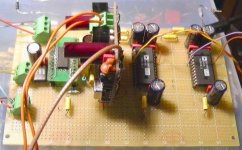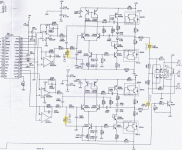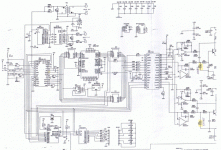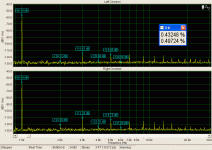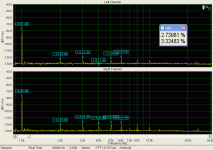Bernhard said:
Philippe,
That means, scaled to how I measure ( -60dB signal is set to 0 dB reference in the analyzer) , you have left channel K3 -40,5 and K5 -45,6. Right channel K3 -44,8 and K5 -55,6.
This is not very good, do you have measurement after distortion adjustment ?
My best PCM56 chips have all harmonics below -62 dB which means -122 dB in your scaling.
Your DAC is non os ? I do not know your chips but i know TDA1541 is getting worse in non os.
Those harmonics will give your DAC a specific sound, only question is if you like it 😀
I prefer the cleanest I can get and I don`t care where it comes from, os or non os. Cleanest I get from os
My references are absolute.
It means, that on the -60 dB diagram, K2 is -116 dB from full scale and K3 is -100dB. The harmonic distortion at -60 dB is about 1%
This is before adjust, but I have to wire the two resistors and the trimmer on each dac to adjust...
On the 0Db diagram, the K2 is at -73dB and K at -92 on one chanel and -112 on the other.
I put also a -80dB diagram, where I have 10% distortion.
My tests signals are on a CD. Odb is a full scale signal (-32767/+32767)
-60db is a full scale/1000 and 80 dB is a full scale/10000.
I think that my results are quite good!!! No ?
On your measurements (if vertical scale is 10 dB/ div and top ref -60 dB), I see the noise floor at approx -110 dB absolute , then it is not very far from what I see on mines.
On this one for example,
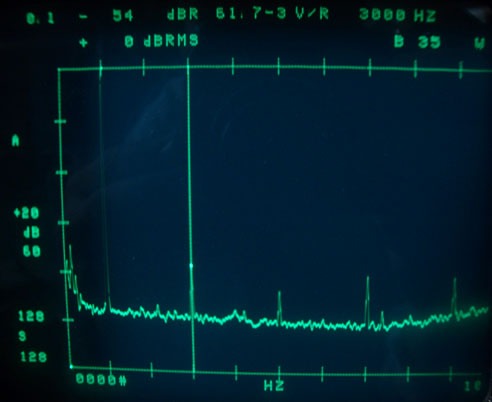
I think that the peak is - 100 dB on these harmonics.
Or I don't read correctly the vertical scale.
Philippe
philbyx said:
My references are absolute.
It means, that on the -60 dB diagram, K2 is -116 dB from full scale and K3 is -100dB. The harmonic distortion at -60 dB is about 1%
This is before adjust, but I have to wire the two resistors and the trimmer on each dac to adjust...
On the 0Db diagram, the K2 is at -73dB and K at -92 on one chanel and -112 on the other.
I put also a -80dB diagram, where I have 10% distortion.
My tests signals are on a CD. Odb is a full scale signal (-32767/+32767)
-60db is a full scale/1000 and 80 dB is a full scale/10000.
I think that my results are quite good!!! No ?
On your measurements (if vertical scale is 10 dB/ div and top ref -60 dB), I see the noise floor at approx -110 dB absolute , then it is not very far from what I see on mines.
On this one for example,

I think that the peak is - 100 dB on these harmonics.
Or I don't read correctly the vertical scale.
Philippe
Your references are absolute to 0dB signal.
-60dB signal with -116dB K2
My references are relative to the measured signal.
If I would measure your DAC I would get -60dB signal = 0dB with K2 = -56dB
To be able to measure the harmonics with my stand alone analyzer, I need to move the cursor to the frequency I wish to have as reference, here 1 kHz, and then set the amplitude at that point to either 1V or 0dB. I set 0dB. When I move the cursor, it always shows amplitude relative to the before set reference.
Back to performance...
As mentioned, I have all harmonics below -62dB that means -122dB in your scale. Also there are no harmonics visible, I assume if they are hidden under noise visually, they will also be hidden sonically.

My noise floor is not flat, it varies between -62dB and -68dB, it is a signal one forum member made for me. In your scale my noise floor is between -122 and -128dB.
Why ? My scale is 10dB/div and display gain is set to 20dB ( vertically shifted up 20dB ), you can see on the left side of the pictures, that means the 1 kHz signal is cut on the top end of the scale, I can only set to 60dB or 120 dB vertical scale and I choose 60dB. That does not affect measurement, just the visible area is a 60dB window.
Another signal from another forum member gives me -61dB noisefloor which is also flat like yours.
On the picture of my measurement, you quoted, the cursor is on K3, the enlightened point shows the peak and you can read on the top left that amplitude here is -54,0 dB which is -114 dB in your scale.
Do you use averaging ? Your noise looks nervous...
I would be really interested to see your measurements after adjustment, get 10-turn pots, it is impossible to adjust with standard pots.
Now it is not very good but I would not expect something else.
You should be able to make all harmonics disappear under noise.
But to achieve that probably you need to select chips, don`t trust K-stamps, this is selected without adjustment.
A totally clean spectrum like you see above is far from K-stamps.
Also it may not be possible to get there without os.
I could not get as good results with other chips like PCM58 and PCM63 and those are 18 bit and 20bit. Poor 16bit PCM56 is better

I have understood!!!
Ok, I understand better now how to read your measures!!!
10dB/div AND 20dB vertical shift
I have to wire the trim pots around the ad1865. I will post the curves before and after trimming.
The noise floor is quite high, perhaps because of my setting (no ground plane on the board) as you can see on this photo :
Philippe
Bernhard said:
To be able to measure the harmonics with my stand alone analyzer, I need to move the cursor to the frequency I wish to have as reference, here 1 kHz, and then set the amplitude at that point to either 1V or 0dB. I set 0dB. When I move the cursor, it always shows amplitude relative to the before set reference.
Why ? My scale is 10dB/div and display gain is set to 20dB ( vertically shifted up 20dB ), you can see on the left side of the pictures, that means the 1 kHz signal is cut on the top end of the scale, I can only set to 60dB or 120 dB vertical scale and I choose 60dB. That does not affect measurement, just the visible area is a 60dB window.
Ok, I understand better now how to read your measures!!!
10dB/div AND 20dB vertical shift
I have to wire the trim pots around the ad1865. I will post the curves before and after trimming.
The noise floor is quite high, perhaps because of my setting (no ground plane on the board) as you can see on this photo :
Philippe
Attachments
Re: I have understood!!!
It depends on your signal, I have two, one gives -60dB and the other one is better.
philbyx said:
The noise floor is quite high, perhaps because of my setting (no ground plane on the board) as you can see on this photo :
It depends on your signal, I have two, one gives -60dB and the other one is better.
Re: I have understood!!!
borrow a page from Jim Williams at Linear Technology -- mount the board in a cookie tin -- (or an Altoids box). You willl be pleased with the amount of noise reduction.
my personal experience is that it is very, very difficult to measure anything below 100dB unless you shield the box.
when measuring very low quantites, the quality of the cables (I use Pomonas) and their position can significantly affect results.
I have a general purpose box with insulated BNC connectors that I use for noise measurements. (It's an OREO box, not Danish butter cookies -- I am sure that some golden-ear will criticize my taste!)
philbyx said:
The noise floor is quite high, perhaps because of my setting (no ground plane on the board) as you can see on this photo :
Philippe
borrow a page from Jim Williams at Linear Technology -- mount the board in a cookie tin -- (or an Altoids box). You willl be pleased with the amount of noise reduction.
my personal experience is that it is very, very difficult to measure anything below 100dB unless you shield the box.
when measuring very low quantites, the quality of the cables (I use Pomonas) and their position can significantly affect results.
I have a general purpose box with insulated BNC connectors that I use for noise measurements. (It's an OREO box, not Danish butter cookies -- I am sure that some golden-ear will criticize my taste!)
PCM53 in a Teac ZD700, only one DAC for both channels.
Noise @ 6000Hz is -66dB, @ 2000Hz -60dB
Tested 3 chips, all look the same.
No adjustments made for distortion, the player has 3 pots, all for noise.
So far the best chip IMHO.
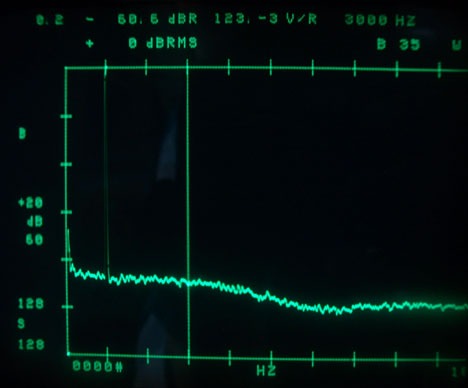
Noise @ 6000Hz is -66dB, @ 2000Hz -60dB
Tested 3 chips, all look the same.
No adjustments made for distortion, the player has 3 pots, all for noise.
So far the best chip IMHO.

Dear Berhard,
I was thomas. I had one problem & hope to collect any advise form U. My ver.2 NOS twin 1541a was factory funish products.
But Taiwan said only can match the distortation of chips to me. Is it good for the DAC??? Because I must pay USD4.5 per pair chips for matching!!!
pls assistance.
thx
thomas
I was thomas. I had one problem & hope to collect any advise form U. My ver.2 NOS twin 1541a was factory funish products.
But Taiwan said only can match the distortation of chips to me. Is it good for the DAC??? Because I must pay USD4.5 per pair chips for matching!!!
pls assistance.
thx
thomas
Hi Thomas,
somebody from Taiwan wants to match TDA1541A ?
Spectrum or THD number ?
You parallel:
left A ll left B & right A ll right B ?
Left channel is always different from right channel.
Maybe if you have 100 or more you can match a few pairs for spectrum.
Maybe you find double crowns
For THD it will be easier. But it can be one channel has lot of K4 and other has lot of K7, same THD but different harmonic content.
See:
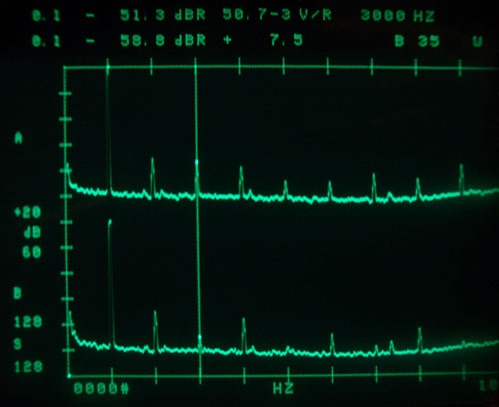
Also see post # 3 & 4
somebody from Taiwan wants to match TDA1541A ?
Spectrum or THD number ?
You parallel:
left A ll left B & right A ll right B ?
Left channel is always different from right channel.
Maybe if you have 100 or more you can match a few pairs for spectrum.
Maybe you find double crowns

For THD it will be easier. But it can be one channel has lot of K4 and other has lot of K7, same THD but different harmonic content.
See:

Also see post # 3 & 4
Will post soon PCM1702, PCM1702-J, Playstation 1 = SCPH-1002, and maybe *** ***** S2.
PCM1702 is very poor, PCM1702-J is better, Playstation 1 is like 14 bit TDA1540.
PCM1702 is very poor, PCM1702-J is better, Playstation 1 is like 14 bit TDA1540.
PCM1702 in differential mode in DCD2700, one channel 2 x J, other 1x J and 1x plain.
Low noise floor typical for 20 bit, but linearity is only mediocre.
K3 are -57,5 and -59,4dB.
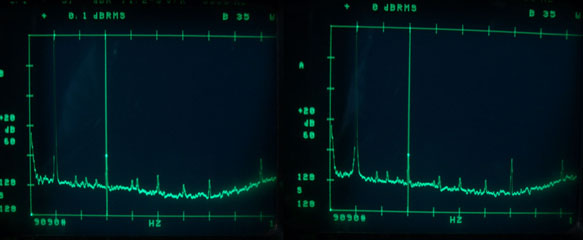
Low noise floor typical for 20 bit, but linearity is only mediocre.
K3 are -57,5 and -59,4dB.

Bernhard,your best one seems to be the Pioneer PD75 with the
PD2028A, I have this machine, with a much improved annalog output stage, it is very smooth but has no dynamic swing when compared to my moded Musical Fidelity A3.24 dac and still using the Pioneer as a transport. The musical Fidelity has a a PCM1738E in it have you had a chach to look at it? As it is so much better than the Pioneer's own dac. Circuit below
Cheers George
PD2028A, I have this machine, with a much improved annalog output stage, it is very smooth but has no dynamic swing when compared to my moded Musical Fidelity A3.24 dac and still using the Pioneer as a transport. The musical Fidelity has a a PCM1738E in it have you had a chach to look at it? As it is so much better than the Pioneer's own dac. Circuit below
Cheers George
Attachments
georgehifi said:The musical Fidelity has a a PCM1738E in it have you had a chach to look at it?
Hi George,
no, never seen a PCM1738E.
Hello
It's me again!!!
see here for previous measurements :
http://www.diyaudio.com/forums/showthread.php?postid=600972#post600972
I made some improvements :
1st : I finished my second D1 I/V, then I am full balanced (two dacs on each chanel).
2nd : I measure with the same audigy card, but I placed a ina2134 between the balanced xlr output of my dac and the RCA unbalanced inputs of the card.
3rd : I installed and trimmed the trimmers around the MSB and trim dac pins.
And here is the result :
At -60dB fs
Philippe
It's me again!!!
see here for previous measurements :
http://www.diyaudio.com/forums/showthread.php?postid=600972#post600972
I made some improvements :
1st : I finished my second D1 I/V, then I am full balanced (two dacs on each chanel).
2nd : I measure with the same audigy card, but I placed a ina2134 between the balanced xlr output of my dac and the RCA unbalanced inputs of the card.
3rd : I installed and trimmed the trimmers around the MSB and trim dac pins.
And here is the result :
At -60dB fs
Philippe
Attachments
Hi Bernhard
I have an old player with the PCM53 and your right about the sound from this dac. I'm planning to build a DAC with a tube output stage and found a DATEL 16bit dac at C&D technology (DAC-HP16BMC) it has same pin out as the old PCM53 from burr brown.. and similar data.
Best regards
Kim Olesen
www.micro-io.dk
I have an old player with the PCM53 and your right about the sound from this dac. I'm planning to build a DAC with a tube output stage and found a DATEL 16bit dac at C&D technology (DAC-HP16BMC) it has same pin out as the old PCM53 from burr brown.. and similar data.
Best regards
Kim Olesen
www.micro-io.dk
Hi Kim,
about the PCM56 in the Teac player: It was so good because Teac added digital noise and removed it in the analog section.
So the DAC never see very small signal and distortion is always low.
I did not know when posting.
I also tried it in a Denon DCD1500 (no mkII) which normally uses PCM54 ( also parallel data in ) measurement result was not so good. For the sound I do not remember, have to try again.
DAC71 also works pincompatible.
How much cost the datel DAC and how it looks ? Picture ?
Bernhard
about the PCM56 in the Teac player: It was so good because Teac added digital noise and removed it in the analog section.
So the DAC never see very small signal and distortion is always low.
I did not know when posting.
I also tried it in a Denon DCD1500 (no mkII) which normally uses PCM54 ( also parallel data in ) measurement result was not so good. For the sound I do not remember, have to try again.
DAC71 also works pincompatible.
How much cost the datel DAC and how it looks ? Picture ?
Bernhard
- Status
- Not open for further replies.
- Home
- Source & Line
- Digital Source
- New DAC measurement
